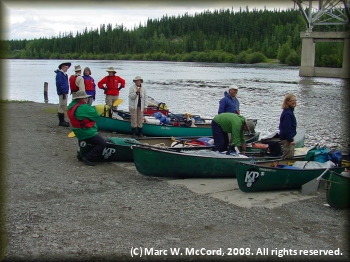 On Sunday, July 27, we shuttled to Johnson's Crossing on the Teslin River and proceeded to launch there. It was a little after noon when we finally got on the water, and some in our group apparently had a hard time telling which way the fast-moving river was flowing. They insisted that we go upstream, and they weren't even Aggies! Finally, being convinced that some of us might be right, they followed, and sure enough the river was still flowing downstream, even in Canada! Whodathunkit?
On Sunday, July 27, we shuttled to Johnson's Crossing on the Teslin River and proceeded to launch there. It was a little after noon when we finally got on the water, and some in our group apparently had a hard time telling which way the fast-moving river was flowing. They insisted that we go upstream, and they weren't even Aggies! Finally, being convinced that some of us might be right, they followed, and sure enough the river was still flowing downstream, even in Canada! Whodathunkit?
We only paddled about 9.69 miles that first day, but it was awesome. We hardly had to paddle at all! The river was flowing at about 7 kph (that's as in kilometers per hour for those who don't understand the nuances of Canadian measurements using the metric system.) It was late - nearly 4 pm - when we got off the water, and it would be dark (for about an hour) in another 11 hours! Paddling this close to the Arctic Circle is a different trip for me. I am accustomed to paddling in hot weather where it gets dark around 9:30 pm and stays that way until around 6 AM. It was difficult adjusting to the fact that daylight was nearly continuous in Canada - just as continuous as the mosquitoes that tried to devour us at every opportunity.
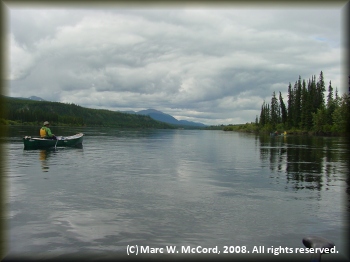 The following day we paddled about 20.32 miles, and our group included several competent fishermen who fed us on Northern Pike and Grayling. It was delicious! I had been eating Heater Meals for several days and planned to eat them throughout the trip, so the fresh catch was an appealing change of pace. Actually, I ate the Heater meals AND the fish! Our campsite was gorgeous, and the nighttime skies were something to behold. The clean, clear air in the Yukon wilderness presents colors that you just don't see in the Lower 48. I was able to take some nighttime photography without flash and get some really spectacular shots of the river and surrounding environment.
The following day we paddled about 20.32 miles, and our group included several competent fishermen who fed us on Northern Pike and Grayling. It was delicious! I had been eating Heater Meals for several days and planned to eat them throughout the trip, so the fresh catch was an appealing change of pace. Actually, I ate the Heater meals AND the fish! Our campsite was gorgeous, and the nighttime skies were something to behold. The clean, clear air in the Yukon wilderness presents colors that you just don't see in the Lower 48. I was able to take some nighttime photography without flash and get some really spectacular shots of the river and surrounding environment.
Almost from the beginning we saw bald eagles, but we were also visited by beavers, river otters, loons, least sandpipers, kingfishers and Roger can tell you what all else we saw. Each day was a pleasant surprise, and things were uneventful until our seventh day on the river. The swift current was carrying us right along at a great clip, and we had the river to ourselves, having seen only one group of moose hunters in motorboats early in the trip and one group of German canoeists on their way to Dawson City far downriver from Carmacks, our destination.
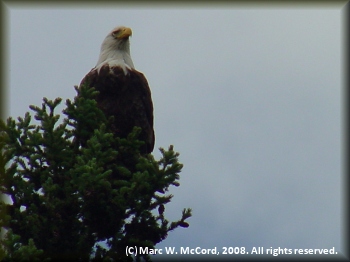 For safety reasons we had discussed taking the clear, open channels whenever we came to divergences around islands. The river was flooded, and we had no way to scout around blind corners, so we wanted to avoid trouble. We came to one particular section where the river split around an island to the right. The left (main) channel was wide open and completely clear. The entry to the right channel had three huge logjams piled up. Our lead boat decided the main channel looked too slow and tame for him, so he peeled off to the right into a blind channel. The next boat tried to follow until the third boat, shouted for them to follow him instead. They had a moment of indecision and got washed, sideways, into the first logjam where the boat immediately came to an abrupt stop.
For safety reasons we had discussed taking the clear, open channels whenever we came to divergences around islands. The river was flooded, and we had no way to scout around blind corners, so we wanted to avoid trouble. We came to one particular section where the river split around an island to the right. The left (main) channel was wide open and completely clear. The entry to the right channel had three huge logjams piled up. Our lead boat decided the main channel looked too slow and tame for him, so he peeled off to the right into a blind channel. The next boat tried to follow until the third boat, shouted for them to follow him instead. They had a moment of indecision and got washed, sideways, into the first logjam where the boat immediately came to an abrupt stop.
I heard three whistle blasts and told Roger that was a distress call, and that somebody in our group was in trouble. We raced toward the area where the river split and saw two of our group sitting in their boat looking (what appeared to us) unconcerned, so we thought the problem was somewhere else. (I have since learned that they were trying to keep the boat from listing upriver and swamping, but that was not apparent to Roger or me as we were fighting a swift current and trying to find who was in trouble.) Nobody signalled or called out who was in trouble, and by the time we realized it was they who were in trouble the swift current had already carried our heavily laden boat past them. It was impossible to get back to them from where we were, so we eddied out on river right alongside the island while others went to their aid.
Soon, gear came floating downriver, and Roger and I grabbed it into our boat - we were in Roger's Old Town Tripper XL, a 20-foot behemoth with a rudder - then lashed his boat to a tree and climbed out onto the island. We worked our way through tundra moss and thick trees to the top end of the island so we could help with the recovery effort, but got there only to discover that there were two deep, fast channels between us and them that we could not get across. So, we offered verbal assistance while a rescue effort was made by other members of our group.
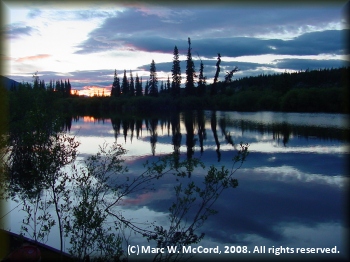 The two in the pinned boat got safely out onto the logjam, and recovered all but one gear bag, then began trying to free the boat. Unfortunately, the effort made was the wrong one, and the boat slid into a pin, and then turned over on its side before wrapping on a root wad with the bow underwater and under the logjam. The bow contained the lone bag that, by that time, could not be freed, and in it were passports, photo IDs, airline tickets, credit cards and cash, as well as some inconsequential items.
The two in the pinned boat got safely out onto the logjam, and recovered all but one gear bag, then began trying to free the boat. Unfortunately, the effort made was the wrong one, and the boat slid into a pin, and then turned over on its side before wrapping on a root wad with the bow underwater and under the logjam. The bow contained the lone bag that, by that time, could not be freed, and in it were passports, photo IDs, airline tickets, credit cards and cash, as well as some inconsequential items.
According to what one member of our group told me, another member of the group had attempted to slide the boat down the logjam and got it pinned. The first guy was miffed, stating that he could have saved the boat were it not for the second guy's erroneous effort. He was very upset, and I told him that the other one had taken an action that, though it did not work, was at least an effort to save the boat, and he should not be blamed for the results. But the first guy, who has had only one swiftwater rescue class without any pinned boat drills, insisted that he could have saved the boat. Considering the times I have had to pull him out of the water and save his boat on other trips I doubt that to be the case.
Roger and I saw the others starting to leave without the boat, so we scrambled back to our boat, paddled across the river to the island where George was standing, and then proceeded to unload our boat. Next, we ferried back across and upstream along the left side of the island from which we had just come. It took some very hard paddling and a lot of energy, but after probably ten or more minutes we made it to where we could secure Roger's boat and wade the river to where the boat was pinned. Gary followed us immediately, and the three of us formed a triangle and waded across the swift current to the logjam where the boat was pinned. By this time Dave and Michael joined our effort, and the five of us spent nearly 4.5 hours trying to free the boat. It was a hopeless effort, and the boat was lost with the gear bag still attached and submerged under the logjam. Now, we had a real problem!
In addition to losing one canoe and a very important bag, the guys in teh first and third boats had continued downriver without so much as a concern. We had no idea where they had gone, and we had not seen the lead boat come out of the right side channel. Roger was adamant about wanting to go that route and see if the guy in the first boat was in trouble. I was equally adamant about not taking that blind path. I explained the first rule of swiftwater rescue - it is better to have one dead person than two or three! Roger said that he was going with or without me, and I was not about to let him go it alone, so I reluctantly agreed, but I explained to him that we might be paddling into certain death. There were three logjams at the top of the island and we had no idea if there were others waiting for us around the corner. He still wanted to try and find the lead boater.
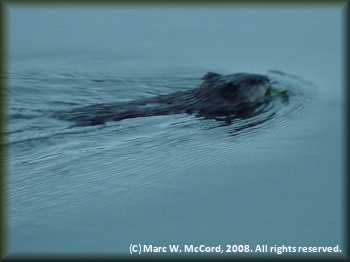 It turned out that the channel was wide open and completely free of any obstacles. It was also painfully obvious that the lead boat had not stopped. We reloaded the three boats that had taken part in the recovery effort, placing the two occupants of the lost in one solo boat and one tandem boat with enough room to carry a third person. I was very uneasy about doing it because of the swift current and cold water, but we really had no choice. We had two solo boats downriver somewhere, and we had no idea about their positions or condition. By this time the two guys who had gone on without us were at least six hours ahead of us in solo boats on a fast-moving river.
It turned out that the channel was wide open and completely free of any obstacles. It was also painfully obvious that the lead boat had not stopped. We reloaded the three boats that had taken part in the recovery effort, placing the two occupants of the lost in one solo boat and one tandem boat with enough room to carry a third person. I was very uneasy about doing it because of the swift current and cold water, but we really had no choice. We had two solo boats downriver somewhere, and we had no idea about their positions or condition. By this time the two guys who had gone on without us were at least six hours ahead of us in solo boats on a fast-moving river.
We chased them downriver for over two days before we finally caught them just below the confluence of the Teslin and Yukon Rivers. They had left four or five messages (they claim five, we saw three) to us along the way telling us they would wait for us there, then proceeded to claim that they thought we were ahead of them, and they were trying to chase us down even though they were the first two boats downriver. I was not amused by their stories, and do not believe either of them. They claimed that they would never have abandoned the group, and that they sincerely thought we were ahead of them, though it boggles the mind to think they could possibly have believed that. They paddled more than 40 miles that day AFTER the incident, and to that point the most miles we had paddled in an entire day was only about 24 miles. The fact is, they DID abandon the group during a rescue situation in grizzly bear country, and that is wholly unacceptable by any standards.
The guy in the lead boat claimed that he had looked back upriver, through binoculars, from a sandbar island toward the big island where the incident occurred, and that he had seen no sign of any of us, which led to his erroneous assumption that we were ahead of him downriver. George, standing on a sandbar island running alongside the big island, had seen the lead boater with his naked eye, but while watching the recovery effort did not see him get back in his boat and continue downriver. The two guys from the separated boats met up somewhere below the incident scene, and then continued paddling downriver together while the rest of us worked the recovery effort on the pinned boat for nearly five hours.
As if these other matters were not enough, the paddler in the lead boat refuses to ever wear a PFD when boating. He carries a Wal-Mart "Mae West" type $5.00 lifejacket that is wholly inadequate to float his weight, and keeps it strapped into his boat, presumably as flotation for the boat. My opinion is that one should actually wear a properly fitted and adequate PFD anytime he or she is boating, but especially on a coldwater, fast-moving wilderness river. Failure to wear a PFD is a risk to the paddler not wearing it and to every other member of the group with whom that paddler is boating. The lead boater apparently feels that he is too good to wear a PFD regardless of the risk to himself or others.
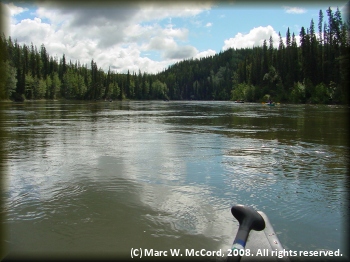 We found them safe and sound at Hootalingua Village, an abandoned telegraph station for river traffic from over 100 years ago. Hootalingua Village is located about a quarter mile below the confluence of the Teslin and Yukon Rivers, and is an historic site that is frequented by river travelers. Some harsh words were spoken, then things calmed down, but a definite "chill" was in the air. We decided to lay over for a day there to regroup and formulate our plans for the remainder of the trip. The Globalstar satellite phone proved to be ineffective in reaching the outfitter. We took the opportunity to explore the area, see the historic sights, climb a mountain and take photos of the confluence from about 500 feet above, then gather our thoughts for the last 100+ miles of the trip.
We found them safe and sound at Hootalingua Village, an abandoned telegraph station for river traffic from over 100 years ago. Hootalingua Village is located about a quarter mile below the confluence of the Teslin and Yukon Rivers, and is an historic site that is frequented by river travelers. Some harsh words were spoken, then things calmed down, but a definite "chill" was in the air. We decided to lay over for a day there to regroup and formulate our plans for the remainder of the trip. The Globalstar satellite phone proved to be ineffective in reaching the outfitter. We took the opportunity to explore the area, see the historic sights, climb a mountain and take photos of the confluence from about 500 feet above, then gather our thoughts for the last 100+ miles of the trip.
The night before we departed we got a wondrous sight - we saw a black bear swimming across the Yukon River toward our campsite. Either he smelled us, or he heard us, but he immediately altered his course and landed about 150 yards upriver from us, then took off like a scalded dog never to be seen again! We got some great photos of the bear in the river, but he disappeared in tall grass as soon as he exited the water, so we did not get any additional photos there. But, Roger did capture a shot of a curious weasel in the old telegraph office building at Hootalingua Village.
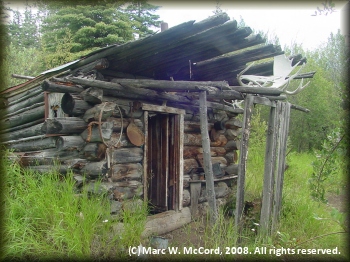 We saw and photographed numerous bald and golden eagles, some hawks and a few beavers. The paddler who was in the lead when the pinning accident occurred and who originally led the other boat into trouble, refused to carry one of them in his boat, and griped about even helping to carry some of their gear. We managed to get everybody into boats with no more than two people per boat, and loaded gear into whatever boats could possibly carry a little more, then made our way downriver. We had four days to make our take-out at our scheduled time, and doing that would be easy enough in the swift current.
We saw and photographed numerous bald and golden eagles, some hawks and a few beavers. The paddler who was in the lead when the pinning accident occurred and who originally led the other boat into trouble, refused to carry one of them in his boat, and griped about even helping to carry some of their gear. We managed to get everybody into boats with no more than two people per boat, and loaded gear into whatever boats could possibly carry a little more, then made our way downriver. We had four days to make our take-out at our scheduled time, and doing that would be easy enough in the swift current.
We paddled out in only three days, stopping at Big Salmon Village and Little Salmon Village to look at sights, take photos and enjoy all that the Yukon had to offer. Along the way we photographed many old, abandoned cabins and other structures in or near campsites. One particularly great campsite was at Claire Creek, just above Twin Creeks, where we had the stream running through our campsite, and several old buildings adjacent to our camp. One was a two-holer toilet with a spectacular view of the forest (it had no door!) Another was a small cabin that had probably belonged to miners, trappers, or both at various times.
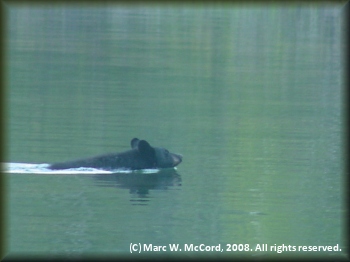 Leaving Claire Creek after our last night on the river we made great progress, but it started to rain cold water as we were breaking camp. We loaded boats with wet gear, then paddled in a moderately but steady rain covering 44.1 miles in just over 6 hours, and arrived at our Coal Mine Campground takeout a day early.
Leaving Claire Creek after our last night on the river we made great progress, but it started to rain cold water as we were breaking camp. We loaded boats with wet gear, then paddled in a moderately but steady rain covering 44.1 miles in just over 6 hours, and arrived at our Coal Mine Campground takeout a day early.
Hot showers. A laundromat. Ice cream. Hamburgers. Free bicycle use to ride into Carmacks. A great riverside campground. Life was good again, and the weather turned very nice for our last day, so Gary and I decided to join a couple of guys from Oregon whom we met at the campground and paddled 25.6 miles from the campground down through Five Fingers Rapid to a campsite takeout just below there. They had run a shuttle in their vehicle earlier that moring, and we set out for an additional day on the river. Along the way we made great time and saw some beautiful eagles, several of which we photographed. Then, we returned to Coal Mine Campground for one last night on the Yukon River.
Sadly, our trip ended with a major tragedy. A Trans North helicopter (a Bell 206B Jet Ranger) took off from a helipad just downriver from us and, as he rotated, dipped into the river, bounced off the water into the trees lining the river, then fell back into the water and exploded underwater. One canoe with two people immediately headed that way to help. Roger and I were preparing to launch when a Bell 212 "Huey" took off from the same helipad and began circling over the spot where the Ranger when down. When I saw the Huey I opted not to go because of fears the rotor wash could put us in peril. The other canoe made it to the spot of the crash and the Huey lowered a cable and hook so they could attach it to the rotor assembly of the downed helicopter, allowing the Huey to lift the Ranger from the river. Unfortunately, the rotor wash flipped the canoe and now two more people were in the 40-45 degree waters of the swift-moving Yukon.
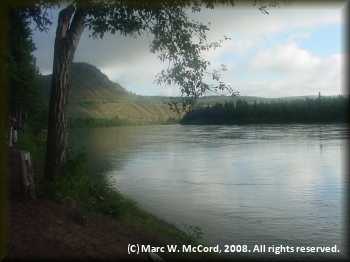 The Huey had to immediately cease trying to find the pilot and get the two canoeists out of the water. They had to be transported to nearby Carmacks and a clinic where they were treated for severe hypothermia. Meanwhile, the Huey returned to its base, refueled, then resumed the search for the missing pilot. The body of Richard Wood was discovered on August 15, a few miles downriver from the accident scene, and was recovered on August 16, from the frigid waters of the Yukon River that were then flowing at about 11-13 knots. Richard Wood was 67 years old with over 24,000 hours in helicopters. He was loved and respected by everybody who knew him, and tragically ended his life doing what he loved most - flying a helicopter.
The Huey had to immediately cease trying to find the pilot and get the two canoeists out of the water. They had to be transported to nearby Carmacks and a clinic where they were treated for severe hypothermia. Meanwhile, the Huey returned to its base, refueled, then resumed the search for the missing pilot. The body of Richard Wood was discovered on August 15, a few miles downriver from the accident scene, and was recovered on August 16, from the frigid waters of the Yukon River that were then flowing at about 11-13 knots. Richard Wood was 67 years old with over 24,000 hours in helicopters. He was loved and respected by everybody who knew him, and tragically ended his life doing what he loved most - flying a helicopter.
We spent Saturday, August 9, in Whitehorse, and then departed for Texas the next day. The ride home was every bit as enjoyable as the drive to Whitehorse had been, though we did it in less than five days. We saw some awesome sights and took a lot of photos. All too soon we were back in the hot, humid Texas weather and longing for the cooler summer temperatures of the Yukon. I have made it a goal to get back there as soon as possible, though not in the winter. It gets entirely too cold, icy and snowy up there for a boy from Texas!
We truly had a trip of a lifetime, and hopefully several people learned some valuable lessons about what to do and what not to do on a wilderness trip. We never saw a grizzly bear, elk, adult moose or caribou, and that is truly a major letdown because we fully expected to see all of them on that 28-day trip. But, it is just one more reason to return to the Yukon.


